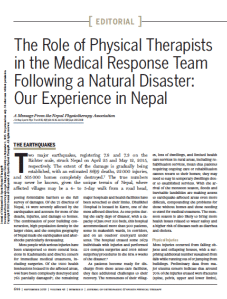A little while ago, we posted an interview with our good friend Saurab, about his experiences as a physiotherapist in Nepal. Last week we received a note from Saurab and a copy of an article, that he co-authored, that discussed the role of physiotherapy following the devastating earthquakes that struck Nepal on April 25 and May 12 earlier this year:
First I would like to thank you for supporting us and keeping us in your prayers during the time of disaster in Nepal. Though the time here was difficult, your support and prayers were significant and valuable. There are no words to thank you.
When the aftermaths of the earthquake were settling down, we took some time to write down about the disaster situation here in Nepal so that people elsewhere would know about our experiences. This produced us an editorial in a reputed journal (article is attached). I am happy to send you a copy to read to know about the situation in greater details.
I also confirm that we are coping well and your support has guided us all the way.
Best regards,
Saurab Sharma
You can read the entire editorial by clicking on the image below.

Some of the key ideas:
Lessons learned
“National and local disaster response plans that include rehabilitation professionals will save lives and optimize the provision of medical services.
The early establishment of a rehabilitation subcluster was critical to supporting this (leadership and coordination of the response), and should be standardized for future responses.
Coordination between the medical and rehabilitation teams at discharge is critical to ensuring continuation of care, especially for patients who have lost their home or live in remote locations.
Do not underestimate the contribution of physical therapists in the acute response to a disaster. They should be ready to assist in the acute management of injuries as far as training and the local health system allow.
Physical therapists are central to the planning and delivering of rehabilitation services in the medium to long term.”
Recommendations
“Physical therapists should make themselves aware of disaster response plans in their organizations, and should play a role in risk assessments relating to hazards in their region.
In disaster-prone areas it is worth considering incorporating principles of acute trauma rehabilitation in disaster contexts into undergraduate physical therapy courses, with a particular focus on specialty areas such as the acute management of spinal injuries and amputees.
Where relevant to scope of practice, it may also be appropriate to provide training in triaging of patients; first aid; basic life support; dressing of wounds; and application of plaster casts, temporary plaster backslabs, and slings. These basic skills may help a physical therapist contribute to a disaster response effort and could be beneficial in accident and emergency departments or in managing injuries in remote areas of the country”
Our thanks to Saurab once again.
-Tim Cocks


Maybe, with our emphasis on ongoing pain we forget the fine work that our colleagues do in the acute trauma theatres. Whether it be the trauma unit at St Thomas in my city, London or in the battle zones around the world…..
DB
London 👍
Reblogged this on saurabsharma's Blog and commented:
It is very generous of NOI to supoort us during the earthquake and to post my email as a blog post at reputed noijam.com. I feel privileged….